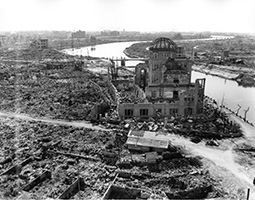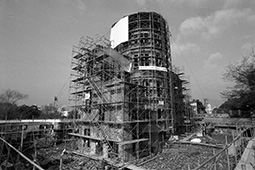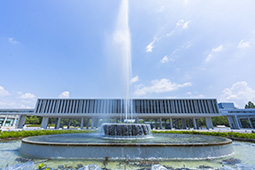April 2023
- English
- 日本語
Hiroshima Peace Memorial (Genbaku Dome)

A river bus passes the Genbaku Dome on the Motoyasu River 
Colored postcard of famous places in Hiroshima (Collection of Hiroshima City Archives)

The Genbaku Dome before the atomic bombing (Hiroshima Prefectural Industrial Promotion Hall) 
Central Hiroshima and the Genbaku Dome photographed after the atomic bombing (November 1945). US Army photograph 
Preservation work on the Genbaku Dome (1990) (Collection of Hiroshima City Archives) 
Hiroshima Peace Memorial Museum

The Genbaku Dome*, which was registered as a World Heritage Site in 1996, is a building that was almost completely destroyed during the first use of the atomic bomb in human history at the end of World War II. The structure’s preservation serves as an ongoing appeal for the abolition of nuclear weapons and to emphasize the importance of lasting world peace.

The Genbaku Dome, which faces the Motoyasu River that flows through the center of Hiroshima City, Hiroshima Prefecture, is a building that was almost completely destroyed by the intense heat rays and devastating blast wind caused by the atomic bomb dropped in 1945.
The Genbaku Dome was originally the Hiroshima Prefectural Commercial Exhibition Hall, designed by Czech architect Jan Letzel (1880–1925) and opened in April 1915. It had an area of around 1,000 square meters, was about 25 meters high, and was built in brick with parts strengthened by reinforced concrete. This European-style building with three main floors, a basement and an oval dome was one of Hiroshima’s landmarks.

The Exhibition Hall was built by Hiroshima Prefecture for the purpose of developing prefectural products, improving their quality, and expanding their sales channels. It was also popular with city residents as a venue for displaying products from inside and outside the prefecture, holding consultations on commerce and industry, and art exhibitions and workshops. In 1933 it was renamed the Hiroshima Prefectural Industrial Promotion Hall. However, after 1944, the building was used by public organizations.
Then, at 8:15 a.m. on August 6, 1945, an atomic bomb detonated 600 meters up in the air, about 160 meters southeast of the building. The building was destroyed and burned down, and all the staff inside the building are said to have died instantly. However, as the blast wind hit the building almost completely vertically from above, the thick-walled center of the building miraculously escaped collapse. City residents came to call it “Genbaku Dome” because the building’s distinctively dome-shaped roof survived as skeletal remains in the shape of an umbrella.

Immediately after the atomic bombing, people said that Hiroshima was so devastated that not even grasses and trees would grow there for 75 years. Nevertheless, reconstruction began. The Genbaku Dome, which has retained its appearance from the time of the atomic bombing, became a symbol of the damage caused by the bombing, nurturing a strong desire for peace in Hiroshima.
Architect Tange Kenzo (1913–2005)**, who designed the Hiroshima Peace Memorial Museum (see sidebar), argued that the Genbaku Dome should be preserved as a symbol, so that humanity would never use atomic bombs again. But at the same time, there was a risk of the building collapsing, and some who wanted it to be removed because they did not want to be reminded of their tragic experiences of the war.

In 1966, the Hiroshima City Council adopted a resolution requesting the preservation of the Genbaku Dome in order to pass on traces of the devastation and of the atomic bombing to future generations. Following this, the City of Hiroshima launched a fundraising campaign for the preservation work. The amount of money received in Japan and from abroad far exceeded the target, allowing the first preservation work to be carried out in 1967. Since then, several rounds of preservation work have been carried out, and the Genbaku Dome still retains its appearance from the time of the bombing.
In 1996, the Genbaku Dome was registered as a World Heritage Site, meaning it would be permanently preserved in its present form.
Today, the Genbaku Dome, which most visitors to Hiroshima go and see, has become a peace monument that appeals for the abolition of nuclear weapons and the importance of lasting world peace.
Note: This article has been created with the consent of Hiroshima City and on the basis of materials published by the city.
Hiroshima Peace Memorial Museum

The museum was designed by Tange Kenzo and opened in 1955 to convey the reality of the damage caused by the atomic bomb to people of all nations. It was also established to contribute to the abolition of nuclear weapons and the realization of lasting world peace, which is the spirit of Hiroshima. The Genbaku Dome can be seen when looking in a straight line from the Peace Memorial Museum, which was built as a symbol of postwar Hiroshima. Items that once belonged to A-bomb survivors as well as photographs and materials showing the devastation of the atomic bombing are on display, conveying the horror of nuclear weapons and what happened in Hiroshima on August 6, 1945. The museum was completely renewed in 2019, with the commentary panel in the main areas and the voice guide available in multiple languages.
1-2 Nakajima-cho, Naka-ku, Hiroshima 730-0811 Japan
https://hpmmuseum.jp/?lang=eng
* Hiroshima City uses the English “Atomic Bomb Dome” for the building’s name.
** See Highlighting Japan November 2017, “Kenzo Tange: The Legacy of an Architectural Legend” https://www.gov-online.go.jp/eng/publicity/book/hlj/html/201711/201711_02_en.html

